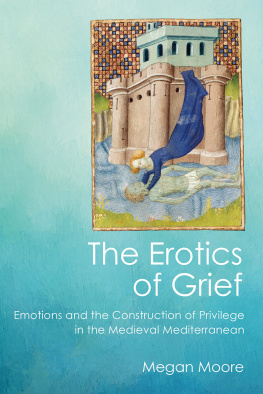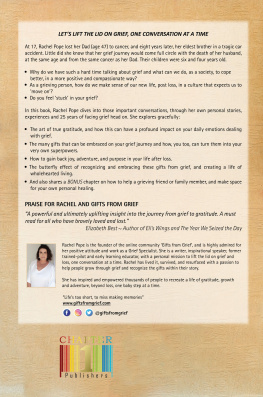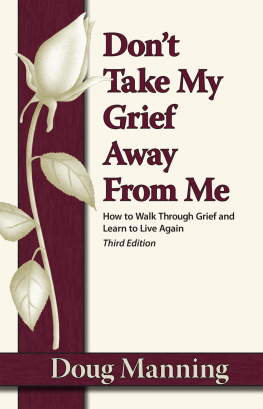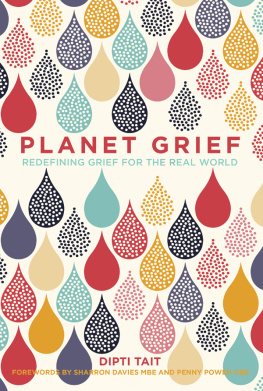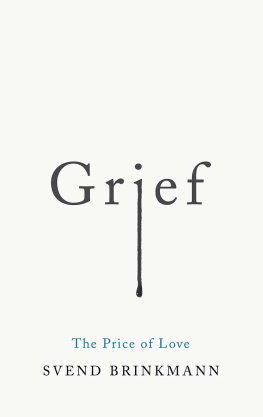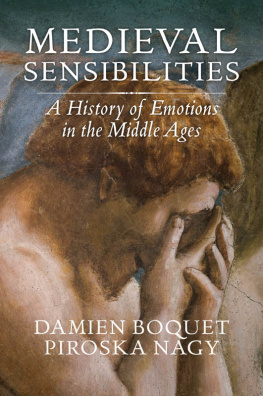My interest in emotions and how they shape our realities was first nurtured in a biology class with Sara Vispoel, who made it possible for a group of high schoolers to attend the thirtieth annual Nobel Conference on Neuroscience in 1994, at which both Oliver Sacks and Antonio Damasio spoke of their (then) recent research on the relation between perception and the biological construction of reality. Saras exceptional work to create such an opportunity not only inspired my continued interest in the neurobiology of emotions but also made me skeptical of received notions delineating certain reactions as inherently biological and others as exclusively cultural.
Conversations with, critical questions posed by, and feedback from Christine Chism, Deborah McGrady, Anna Watz, Simon Gaunt, Peggy McCracken, Ingela Nilsson, Stavroula Constantinou, Anthony Kaldellis, Ryan Milov-Crdoba, Marla Segol, Christopher Davis, David Rollo, Romain Brthes, and David Konstan have challenged my thinking in this project. My continued discussions of medieval affect with Emma Lipton, Johanna Kramer, Anne Stanton, and Rabia Gregory have proven invaluable. Invitations to present parts of this work by Stephanie Trigg, Claire Gilbert, Lynn Ramey, Adam Goldwyn, Aglae Pizzone, and Dimitrios Krallis have provided space for me to test and refine many of the ideas presented here.
Stimulating conversations during meetings of the Mediterranean Seminar, a wonderful gathering of thoughtful, generous scholars, proved invaluable to this project. The seminar dedicated to Emotions, Passions, and Feelings, which was organized by Marianne Kupin-Lisbinat and Thomas Devaney, at which I workshopped the fourth chapter, was integral to shaping this book. I am so grateful to Sharon Kinoshita and Brian Catlos, the founders of the seminar, for the many ways their work continues to shape our field of inquiry as well as enhance the collegiality of and connections between our work, and to Sharon in particular for her feedback.
I offer my thanks to the libraries and institutions whose support changed the trajectory of this book, above all to the staff of the manuscript reading room at the Bibliothque Nationale for their time and energy in helping me find and identify pertinent manuscripts; I am grateful to the Bibliothque Municipale in Lyon, the British Library, the Bodleian Library, the Bayerische Staatsbibliothek, the Getty Museum, the Pierpont-Morgan Museum, and the Newberry Library. Likewise, the attentiveness and support of the students, faculty, and staff during my brief residency at the Center for the History of Emotion in Melbourne helped me refine the kinds of questions I wanted to address in the project in its nascent stages. I thank the Australian Research Council for facilitating my stay and especially Stephanie Trigg for her feedback on emotions and performance.
I am grateful to the University of Missouri Research Board for sponsoring the researching and writing of this project, and to many of my colleagues for their feedback over several years. Without the enthusiasm and support of Flore Zphir this project would not have been possible, and I am so grateful to Daniel Sipe for the many conversations we have had about the relation between emotion and human experience. I also thank my colleagues Kristy Bowers, Lee Manion, Phong Nguyen, and John Evelev for ideas and suggestions as I have begun to think forward from this project, as well as Myles Freborg and Veronica Mohesky for their help in conducting research.
Thanks also to Jessie Aucoin, Emilia Yasamin, Amy Newbrough, Andrew Donnelley, Erica Titus, and Christine Livingston for offering readings of the erotics of death in modern culture. Special thanks to my mother, Wendy Chappelear, who as a psychologist piqued my interest in the brains responses to feelings, and to David Palit, whose discussions of emotions always resolutely returned to stoicism and the suppression of emotion as a sign of refinement; to Marie Lerchner, whose spirit and constant care made my writing that much easier; and to Alicia Platte, whose smiles filled our home with joy while I wrote. Lastly, I am grateful to Toby Oshiro for his wonderful, critical ear and his love for words, what they can do, and the richness they can convey.
From the Bibliothque Nationale de France
Franais 52, fol. 7v, Charlemagne trouvant Roland mort
Franais 60, fol. 97, Lamentations sur Hector
Franais 97, fol. 23, Tristan et demoiselle se lamentant
Franais 97, fol. 328v, Faran de la Tour pleur par son amie
Franais 100, fol. 36, Lamentations sur Meliadus
Franais 102, fol. 247v, Tristan et demoiselle se lamentant
Franais 112 (3), fol. 111v, Mort dErec
Franais 112 (3), fol. 113v, Arthur pleurant Erec
Franais 112 (3), fol. 206, Gauvain pleurant ses frres
Franais 119, fol. 369v, Agravain au Tertre as Caitis
Franais 123, fol. 244v, Arthur pleurant ses neveux
Franais 310, fol. 370v, Charlemagne pleurant Roland
Franais 334, fol. 294, Tristan et demoiselle se lamentant
Franais 344, fol. 319v, Lamentations devant le lit de Lancelot
Franais 364, fol. 89F, Pyrrhos I pleurant les morts
Franais 364, fol. 105v, Pyrrhos I pleurant les morts
Franais 750, fol. 311v, Tristan et demoiselle se lamentant
Franais 782, fol. 183v, Lamentation sur Ajax
Franais 6465, fol. 113, Mort de Roland
Franais 1433, fol. 69v, Lamentations sur Esclados
Franais 2820, fol. 133v, Charlemagne pleurant Roland
Franais 22554, fol. 141, Achille pleurant les morts
Franais 24364, fol. 35, Alexandre pleurant les morts
Grec 2878, fol. 195v, Lamentations sur Pris
Latin 4915, fol. 97v, Mort dAlexandre
N.A. Franais 24920, fol. 34v, Polyxne pleurant Achille
N.A. Franais 886, fol. 12v, Lamentations sur Barkiyruq
Smith-Lesouf (oriental) 244, fol. 6, Lamentations sur Suhrb
Supplment persan 489, fol. 436v, Ram Burzn devant le corps de Nshzd
Supplment persan 581, fol. 105, Lamentations sur Husraw II
From the British Library
BL Royal MS 16 G VI, fol. 180v, Charlemagne mourning Roland
BL Royal MS 20 D IV, fol. 168v, A woman mourning in a tent as Agravain rides up
From the Getty Museum
MS 63, fol. 41, Suicide of Dido
From the Koninklijke Bibliotheek
The Hague, KB, 78 D 47, fol. 90v, Mourning for Brutus: the dead body is brought to Rome
The Hague, KB, 134 C 19, fol. 92v, Mourning the dead Strabo
The Hague, KB, 134 C 19, fol. 242r, Cornelia with her company mourning Pompey and weighing anchor to flee
APPENDIX 2
Selected Illuminations of Lovers in Death
From Arsenal
Arsenal 5069, fol. 159, Alcyon metamorphos embrassant le cadaver de Cyx
From the Bibliothque Nationale
Franais 239, fol. 273, Gentil Carisendi exhumant Catalina
Franais 598, fol. 20v, Suicide de Thisb
Franais 606, fol. 18v, Suicide de Thisb
Franais 874, fol. 40, Didon se lamentant
Franais 2810, fol. 149, Roi profanant le corps de son amie
Grec 2736, fol. 40v, Vengeance de Mde
From the British National Library
Harley 4867, fol. 51, Dido
From the Getty
MS 63, fol. 41, Suicide of Dido
MS Ludwig XV 7, fol. 29v, Love instructing the Lover in the Roman de la Rose
From the Pierpont Morgan
Morgan Library M. 126, Thisbe in the Confessio amantis
BIBLIOGRAPHY
Primary Sources and Translations
Aquinas, Thomas. Summa Theologiae. Edited by Petrus Caramello. Turin: Marietti, 1952.

